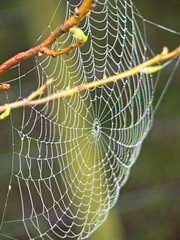The Web of Life
Where Are We Headed?
The web of life is in grave danger. No one knows where we are headed, but we are running faster than we ever have to get there. Chaos? World War? A series of regional wars? The use of weapons of mass destruction? Chemical, biological, or nuclear attacks? Earth and climate changes? Pole shifts? Two hundred mile an hour winds swirling over the planet, destroying all plant life, most homes and buildings, and nearly all of us? Massive earthquakes? Volcanic eruptions? Tidal waves? Floods? Water appearing where it hasn’t been seen in cen- turies? Planetary warming? Gaping holes in the ozone layer? Famine? Chronic drought? Starvation? Plagues? Incurable infectious diseases? These are all symptoms of irreparable damage to the web of life.
Presently, nearly two billion people in the world are without access to clean drinking water. Two hundred fifty thousand new babies are born everyday. Estimates suggest that by the year 2015 there will be 8.5 billion people on the planet, increasing the present population by nearly a third. Virtually all that growth will occur in the third world where there is not enough fresh water, food, housing, or economic opportunity as it is. The additional population will become a source of new crises and increased conflict that will impact the whole world and further shred the web of life. As it is, AIDS cases are rising dramatically in the third world and are beginning to climb again in America following a period of slow growth.
Degenerative Diseases
In the United States, over one third of the population now has Insulin Resistance Syndrome, a leading precursor of diabetes and heart disease. Sixty percent of the population is overweight. Statistics indicate that one out of two Americans will contract some form of cancer during their lifetime. If we do not destroy ourselves through ideological and cultural divides, limited economic opportunity, war, lack of food and clean water, we may well destroy ourselves by eating processed foods, packed with refined sugar and carcinogens, breathing toxic air, and drinking contaminated water.
Global Imbalance
Unfortunately, what we are doing to ourselves is only part of the saga in the growing epidemic of global imbalance. The other part of the story is what we have done to the earth’s ecosystem, its web of life. Because of our prolific capacity for heedless pollution, nature is fast losing her capacity to regenerate herself and restore the web of life, and may one day fail to support us. The natural world is our foundation. Our continued existence is impossible without its embrace.
The Web of Life
Why is it that as human beings we hurt and destroy nearly everything we touch? Could it be because we are out of touch with our true nature and have no respect for or sensitivity to things, species, and people outside of ourselves? We’re not the only show in town or the only species on the planet. When we uproot and destroy everything in our path in the name of profit and power, we sow the seeds of our own destruction. Life is a web, and all species on the planet, including us, are contained and connected within that web of life. Destroy one part of that intricate network and the web of life is suddenly out of balance.
Without systemic balance, all the individual elements of the web of life will eventually suffer. Interfere with the ability of several elements of the web of life to function as intended, and that suffering will come much faster and cut much deeper. We may well be at that point now. The overriding ecological question of our time is whether or not we have reached the point of no return. Is there still time for us to rise to the challenge, overcome the polarization that plagues us, and save ourselves, the web of life and our fragile ecosystem from overwhelming degradation?
Degradation of the Ecosystem
Of course, the degradation of the ecosystem and the web of life contribute to the rise of epidemics. When we rip the web of life asunder, pollute the environment, and make the world more toxic, we create the conditions for that toxicity to come back to haunt us. When we destroy our foundation, the web of life, we put our future at risk. In a famous and controversial speech made in 1854, but not reported on until thirty-three years later, Chief Seattle of the Suquamish Indians was attributed with the following remarks: “Whatever befalls the earth befalls the children of the earth. We did not weave the web of life; we are merely strands in it. Whatever we do to the web, we do to ourselves.”
This post is excerpted from JUST WHO DO YOU THINK YOU ARE? by Alan Mesher



